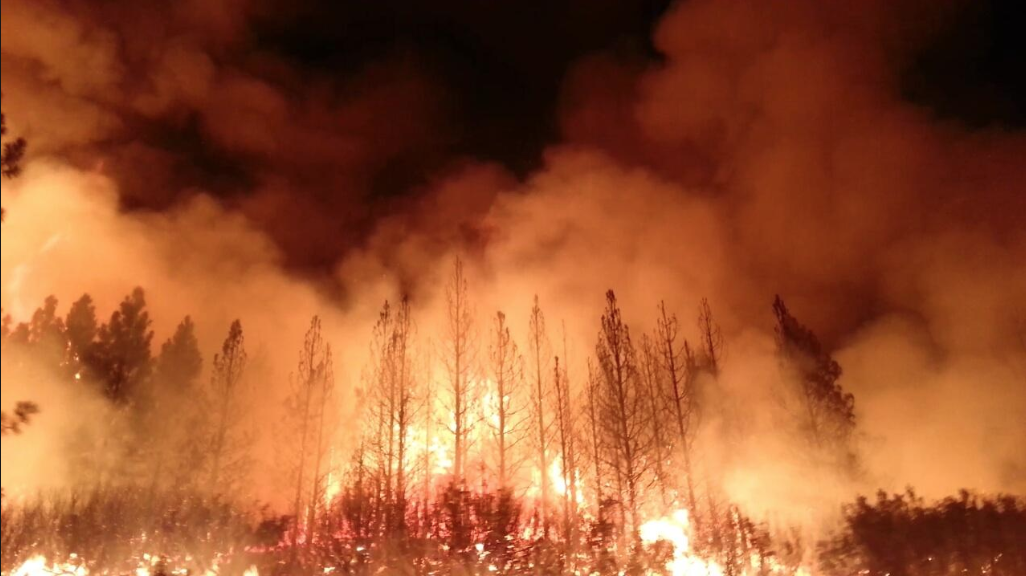The fourth National Climate Assessment released by the government last week details the current and future impacts of climate change on the planet, including calamaties like increased and more intense wildfires, something we’ve seen plenty of this year. Photo courtesy Wikipedia Commons.
By Helen Neville
No amount of couch-ridden lethargy or Black Friday shopping could bury the impact of the Fourth National Climate Assessment released the day after Thanksgiving. This report, mandated by Congress, is no stuffed turkey — compiled by over 300 scientists from 13 federal agencies, it represents the latest in our scientific understanding of climate change and its current and predicted impacts.
Profiled in various national media outlets and summarized and available to the public here, it is by far the most vivid picture of the impacts that climate change is having on the United States now, and into the future. I urge all of our members to take the time to read it.
The report warns of impacts even those who are not nature- or conservation-oriented will take pause in, outlining threats like hundreds of billions lost annually from our economy, increased health risks from disease and pollution, agricultural failures and less productive fisheries, and even the mass migration of Americans from especially hard-hit regions of the country, like the coasts. In a year where climate change has undeniably affected many Americans, face-on and in unprecedented extremes, the report also further details the science behind increasingly intense wildfire, hurricanes and drought. Importantly, this most recent report draws from major advances in “attribution science” made since the last report, four years ago, to quantify the contribution of climate change to different events – such as in this self-explanatory wildfire graphic
Though all of this can seem daunting and down-right paralysis-inducing, other recently-released science has me a bit more hopeful in terms of what TU is doing to help. I’ve been doing some reading lately to learn more about habitat restoration and carbon sequestration, suspecting this to be an important but unsung aspect of TU’s work. We routinely quantify “miles of stream restored”, we monitor increases in numbers of fish, and we are even beginning to measure the amount of water our restoration helps to capture. But the habitat improvements we do across the country also store carbon (!), and a recent paper in the journal Global Change Biology, entitled “Carbon sequestration in riparian forests: A global synthesis and meta‐analysis”, suggests these activities store more carbon than any of us recognize.
In the paper, Kristen Dybala and coauthors analyze findings across 117 studies focused specifically on riparian vegetation; they note that in previous carbon sequestration studies, riparian forests have not been separated from upland forests even though the more favorable growing conditions in riparian corridors (encouraged through soil moisture and other factors) may allow for quicker accumulation of carbon. Indeed, the authors find that, on average, the reestablishment of riparian forests can more than triple (a greater than 200% increase) the carbon stored in the soil compared to baseline conditions. This is impressive in itself – but it also represents a much higher contribution to soil carbon storage than earlier estimations of forest reestablishment (0 to 83 percent over baseline) which focused on reforesting croplands. The amount of carbon stored in biomass, i.e. the plant material in a riparian forest, was not as dramatically different relative to other types of forest regeneration (see below figure), but still represents a comparably significant aspect of carbon sequestration.
Figure 4, from Dybala et al. 2018: Amounts of carbon per hectare are shown for different forest types, with the contribution of riparian areas assessed in this study shown in black and compared to estimates from the 2006 Intergovernmental Panel on Climate Change, shown in grey.
One unique aspect of this study is that the authors modeled change over the long-term and so the above average soil carbon storage was, unfortunately, estimated to take over 100 years – not fast enough. But the study also evaluated the effect of a common and relatively simple TU chapter activity that could expedite storage: riparian planting. They showed that active planting can significantly jump-start biomass sequestration by doubling riparian forest growth rates over the natural progression of unplanted vegetative recovery.
The take-home of all of this? Climate change is here, it is happening, and we cannot ignore it — we must all do our part to reduce greenhouse gas emissions, fast.
In the coming months, I hope to help us figure out how to quantify the degree to which our every-day restoration activities are doing just that. The contribution will, I suspect, be significant: Dybala et al. (2018) state that “Floodplains are estimated to cover only 0.5 percent–1 percent of the global land surface, up to an estimated 2 million km2…if all of these floodplains were forested, they would have the potential to store a total of 13.6–31.4 billion Mg C [milligrams of carbon] in woody biomass alone, or 2.9 percent to 6.7 percent of the estimated 466 billion Mg C currently stored in vegetation world-wide (IPCC, 2000).”
What could be the impact of all the restoration we do, every day, all across the country? Sounds like an unsung TU song to me.
Helen Neville is TU’s senior scientist. She lives and works in Boise.



